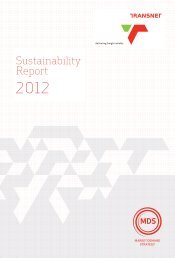Noise and Vibration Report - Transnet
Noise and Vibration Report - Transnet
Noise and Vibration Report - Transnet
- No tags were found...
Create successful ePaper yourself
Turn your PDF publications into a flip-book with our unique Google optimized e-Paper software.
ENVIRO-ACOUSTIC RESEARCHSCOPING NOISE REPORT – TRANSNET: SWAZI RAIL LINK – DAVEL YARD TO NERSTON RSA ROUTEthat between 30 <strong>and</strong> 40 dB, several effects are observed, with the chronically ill <strong>and</strong> childrenbeing more susceptible; however, “even in the worst cases the effects seemmodest.” Elsewhere, the report states more definitively, “There is no sufficient evidence thatthe biological effects observed at the level below 40 dB (night, outside) are harmful tohealth.” At levels over 40 dB, “Adverse health effects are observed” <strong>and</strong> “many people haveto adapt their lives to cope with the noise at night. Vulnerable groups are more severelyaffected.”The 184-page report offers a comprehensive overview of research into the various effects ofnoise on sleep quality <strong>and</strong> health (including the health effects of non-waking sleep arousal),<strong>and</strong> is recommended reading for anyone working with noise issues. The use of an outdoornoise st<strong>and</strong>ard is in part designed to acknowledge that people do like to leave windows openwhen sleeping, though the year-long average may be difficult to obtain (it would requirelonger-term sound monitoring than is usually budgeted for by either industry orneighbourhood groups).While recommending the use of the average level, the report notes that some instantaneouseffects occur in relation to specific maximum noise levels, but that the health effects of these“cannot be easily established.”2.6.3 Equator PrinciplesThe Equator Principles (EPs) are a voluntary set of st<strong>and</strong>ards for determining, assessing<strong>and</strong> managing social <strong>and</strong> environmental risk in project financing. Equator Principles FinancialInstitutions (EPFIs) commit to not providing loans to projects where the borrower will not oris unable to comply with their respective social <strong>and</strong> environmental policies <strong>and</strong> proceduresthat implement the EPs.The Equator Principles were developed by private sector banks <strong>and</strong> were launched in June2003. The banks chose to model the Equator Principles on the environmental st<strong>and</strong>ards ofthe World Bank <strong>and</strong> the social policies of the International Finance Corporation (IFC). 67financial institutions (October 2009) have adopted the Equator Principles, which have becomethe de facto st<strong>and</strong>ard for banks <strong>and</strong> investors on how to assess major development projectsaround the world. The environmental st<strong>and</strong>ards of the World Bank have been integrated intothe social policies of the IFC since April 2007 as the International FinanceCorporation Environmental, Health <strong>and</strong> Safety (EHS) Guidelines.2.6.4 IFC: General EHS Guidelines – Environmental <strong>Noise</strong> ManagementThese guidelines are applicable to noise created beyond the property boundaries of adevelopment that conforms to the Equator Principle.P a g e | 13
















